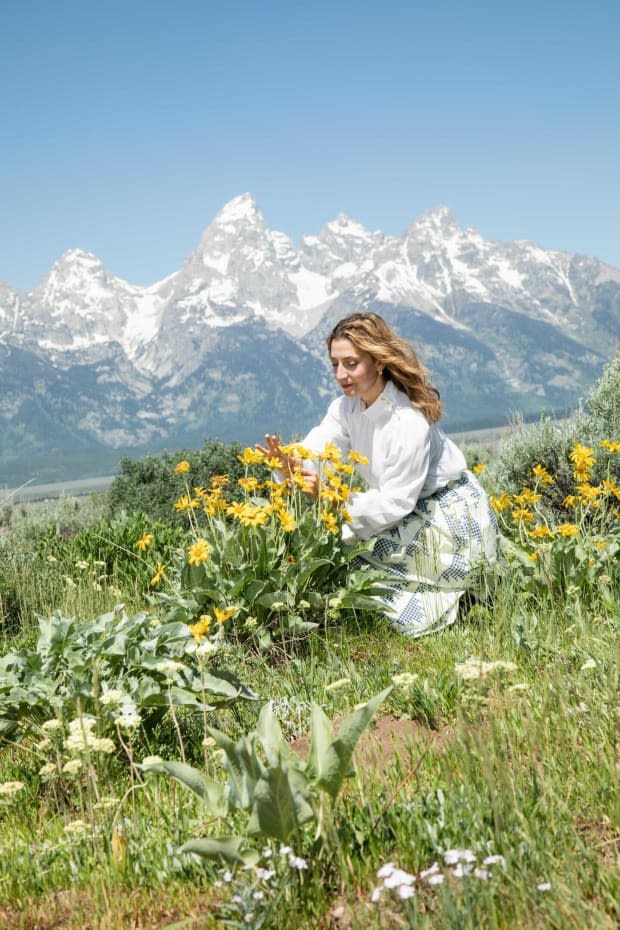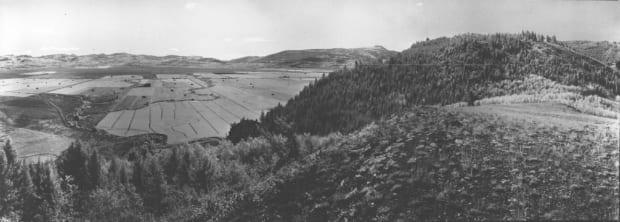Can a Beauty Brand Help Restore Our National Parks?
Alpyn Beauty, a skin-care label made with botanicals grown in the Grand Teton wilderness, is trying.
In the 1890s, Mormons came to Jackson Hole.
The homesteaders arrived from Idaho, 300 miles west, having been tasked by leaders of the Church of Jesus Christ of Latter-day Saints to expand their community's growing foothold in the region. They settled due east of Blacktail Butte, a landform rising from Wyoming's fertile Jackson Hole valley in what we now call Grand Teton National Park. Europeans, however, had started to colonize the Teton area decades earlier, through the 1830s, at which point many Indigenous peoples — including the Shoshone, Bannock, Blackfoot, Crow, Flathead, Gros Ventre and Nez Perce tribes — occupied the land.
Grand Teton National Park didn't exist yet, of course. It wouldn't until 1929, when the National Park Service turned its attention to protecting the Rocky Mountains' Teton Range. So for now, Jackson Hole's latest party of settlers made themselves at home, building farmsteads for themselves and cultivating grasslands for their livestock.
In time, they grew quite successful. Between 1896 and 1937, pioneers established 27 homesteads throughout the Jackson Hole valley in a stretch the National Park Service today calls "Mormon Row." By the 1950s, many families sold their plots to conservationists looking to add to the existing park. Relics of Mormon Row still remain, barns and log cabins dotting the limestone horizon.
Though that's not all the homesteaders left behind. When settlers went about creating those 27 homesteads, they cut down much of the existing flora — woody sagebrush, mostly — in favor of a non-native smooth bromegrass, a leafy, sod-forming perennial that's remarkably resistant to extreme weather. It can also, crucially, feed cattle.
But smooth brome is also considered invasive. It may cater to some wildlife for a small portion of the year, but it otherwise excludes the native plant and animal species that depend on the landscape to survive. And since the early 1900s, it has continued to spread and spread and spread, leaving us now with nearly 4,500 acres of ravaged grassland. This has broader environmental ramifications beyond the valley: Invasive plants can cause biological pollution, and are among the leading causes of biodiversity loss.
Which is where the beauty industry comes in. As it turns out, the Grand Tetons are something of a skin-care Shangri-la. Because among the sagebrush once grew a bevy of skin-care superheroes like arnica, calendula and nettle, ingredients that contemporary cosmetics brands source in droves. This was not known to 20-year beauty industry veteran Kendra Kolb Butler when she uprooted her life to move to Wyoming, however.

Photo: Courtesy of Alpyn Beauty
"My husband and I decided to do a radical change," says Kolb Butler, who had previously worked in marketing and public relationships for blue-chip beauty companies like Coty, Clarins and Dr. Dennis Gross. "We left our corporate jobs, packed up everything we owned and drove west to Jackson Hole. We had intended to stay for three months to press the reset button and then go right back to New York. Years later, we're still here."
Try as she might to reset fully, Kolb Butler couldn't quit the beauty industry. She opened two local beauty stores to keep her finger on the pulse of ingredient trends and new launches, bringing the luxe likes of Tata Harper to the sleepy (albeit still luxe) mountain town. But soon, Kolb Butler hit a snag: What worked in her concrete Manhattan playpen did not necessarily translate to alpine living.
"Women were coming into the stores, and I started to notice a trend with very accelerated aging patterns," she remembers. "I'd have 30-year-old women come in and they would look like they were 40. I started to see changes in my own skin. My skin was falling apart."
In Kolb Butler's new home, the elements — the sun damage, the low oxygen, the aridity — were all kicked up a notch. Jackson Hole is 6,200 feet above sea level, just more than a mile high; the top of the tram at Jackson Hole Mountain Resort, known for its steep terrain and upscale clientele, sits at 10,450 feet. The ground elevation in Manhattan, meanwhile, ranges from just seven feet above sea level between the Brooklyn and Manhattan bridges to 13 at the base of the Freedom Tower. All of this manifested on her skin — and her business plan.
"I was getting a lot of returns on the skin care I was selling," she says. "Women would come in three days after buying a hundred-dollar moisturizer and say, 'Kendra, it doesn't work. I'm still so dry. What else do you have?'"
At first, she wasn't exactly sure. For all intents and purposes, her apothecary was ineffectual, a glorified tribute to the humid subtropical conditions she left behind in the Empire State. The lightbulb flicked on while she was watching dusk fall across the Grand Tetons from her backyard.
View the original article to see embedded media.
"I was looking at the forest," she recalls, "and I wondered, 'What's growing here, and why does it look so healthy? How has nature adapted to this climate that's sucking the life out of human skin?'"
Enter sagebrush, which, when healthy, fosters all sorts of skin-care saviors, from dandelion to bearberry. "I thought it was so ironic that in a town filled with women with skin problems, there were wild skin-care ingredients growing out of every nook and cranny."
Kolb Butler got to work, safely (more on that later) harvesting what literally grew in her own backyard and courting labs to churn out some samples. While most facilities strictly source materials from official ingredient suppliers, she eventually found one game enough to turn her plants into something topical. Samples in hand, she started giving them away at her store.
"After that, I couldn't walk through the grocery store without people grabbing me by my shoulders being like, ‘What was that moisturizer?'" she says. "It was just the same plants we're walking our dogs over every day without realizing that sometimes, the antidote's hiding in plain sight."
In 2018, Kolb Butler's Alpyn Beauty was born, formulated with a proprietary complex of hand-cultivated botanicals grown in the Grand Teton wilderness. "Alpyn" (pronounced "al-pin") is an ode to the region's alpenglow: an ethereal pink light cast at sunrise and sunset that illuminates the mountaintops, forests and valleys where the brand's ingredients grow.
Three years in, Alpyn's harvests no longer come from Kolb Butler's personal lawn, but rather the brand's own private plot of land near Grand Teton National Park proper — land that had previously been home to such Native peoples as the Shoshone, Crow and Blackfeet, three of the major Indigenous tribes of what is now Wyoming. ("Wyoming" itself comes from the Algonquin words for "land of vast plains.") It swears by a process it calls "wildcrafting," which she defines as "sustainably harvesting a plant from its natural growth environment." When you wildcraft properly, she says, you never kill the plant. Instead, botanist farmers (who specialize in wildlife that's indigenous to Wyoming) extract a sliver of the nutrient-dense section — typically the stem, fruit or flower — and leave the plant as-is.
"It's similar to taking strawberries off of a bush," she says. "If you want to get strawberries, you don't hack down a bush and bring the bush back to your house."
While Alpyn doesn't forage from the park itself, it's critical that the brand's plants remain healthy and intact for the sake of the park, as well as the greater ecosystem as a whole. It's why smooth brome has put such huge swathes of the park in jeopardy. As Maddy Johnson, communications manager and development officer at the Grand Teton National Park Foundation, Alpyn's 1% for the Planet partner, explains, the Grand Tetons are a part of the greater Yellowstone ecosystem, which is one of the largest, nearly intact temperate ecosystems on Earth: "It's very important for the park to maintain that natural habitat to the best of its ability to preserve this ecosystem. It's incredibly special and valuable for our country and our planet, really."

Photo: Courtesy of the National Park Service, Grand Teton National Park, Historic Fire Records, GRTE-00552, Photographer LM Moe
In 2007, the Grand Teton National Park Foundation began to do something about it, pledging to restore those 4,500 acres of smooth brome back to its natural sagebrush habitat, where pastures come alive with native flora and fauna once again. They call it "rewilding," the process for which is, in a word, tedious, but for good reason: Any new plant life that's planted needs to come from native seeds within park boundaries. Now 14 years in, nearly 1,500 acres are in some phase of restoration. But there's much more work to be done.
"After one of my visits to the park, I came back and was just like, 'Wow, they need so much help,'" says Kolb Butler. "They don't have the machinery they need because it's very expensive. They're not farmers, they're a nonprofit. How could we do more?"
Alpyn's answer, at least for the time being, came by way of its Magic Mountain Discovery Kit, from which 25% of proceeds go directly toward the foundation's restoration efforts. Released last month, the kit includes a trio of products — a cleanser, a peel and a moisturizer — designed to cleanse, exfoliate and hydrate in even the harshest of climates.
Kolb Butler is aware that consumer packaged goods like hers aren't a cure-all. The most important piece of the kit, she says, isn't the products themselves, but rather the packaging that raises awareness of native habitats in general.
"If you're visiting a park, always be mindful of their rules because they're in place for a reason," she says. "We can do a lot of damage just walking through, with seeds or manure or an insect on our shoe. The whole ecosystem, it's just so delicate. It's like the most fragile piece of glass you've ever held. It can get destroyed pretty fast."
For Alpyn, rewilding is not exclusive to those in mountainous valleys, flanked by prairies and streams. Johnson says anyone can rewild, even those city dwellers engulfed in pavement, like Kolb Butler once was. If you have access to an outdoor space, be that a private yard or a city plot, choose native plants that will be able to survive in the climate.
"I do think the first step in rewilding, though, is not having to do it at all," adds Johnson.
Back in Manhattan, Kolb Butler didn't have her own lawn from which to forage huckleberries. But she does now, and that's what her brand is all about.
"Come with us into the forest," she says. "Let's go in the alpenglow. Let's harvest some plants. Let's smell the sage. It's a break from reality."
Want more Fashionista? Sign up for our daily newsletter and get us directly in your inbox.
